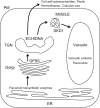Arabidopsis ECHIDNA protein is involved in seed coloration, protein trafficking to vacuoles, and vacuolar biogenesis
- PMID: 32201898
- PMCID: PMC7475254
- DOI: 10.1093/jxb/eraa147
Arabidopsis ECHIDNA protein is involved in seed coloration, protein trafficking to vacuoles, and vacuolar biogenesis
Abstract
Flavonoids are a major group of plant-specific metabolites that determine flower and seed coloration. In plant cells, flavonoids are synthesized at the cytosolic surface of the endoplasmic reticulum and are sequestered in the vacuole. It is possible that membrane trafficking, including vesicle trafficking and organelle dynamics, contributes to flavonoid transport and accumulation. However, the underlying mechanism has yet to be fully elucidated. Here we show that the Arabidopsis ECHIDNA protein plays a role in flavonoid accumulation in the vacuole and protein trafficking to the vacuole. We found defective pigmentation patterns in echidna seed, possibly caused by reduced levels of proanthocyanidins, which determine seed coloration. The echidna mutant has defects in protein sorting to the protein storage vacuole as well as vacuole morphology. These findings indicate that ECHIDNA is involved in the vacuolar trafficking pathway as well as the previously described secretory pathway. In addition, we found a genetic interaction between echidna and green fluorescent seed 9 (gfs9), a membrane trafficking factor involved in flavonoid accumulation. Our findings suggest that vacuolar trafficking and/or vacuolar development, both of which are collectively regulated by ECHIDNA and GFS9, are required for flavonoid accumulation, resulting in seed coat pigmentation.
Keywords: Arabidopsis thaliana; trans-Golgi network; ECHIDNA; GREEN FLUORESCENT SEED 9; mucilage; protein sorting; seed coloration; vacuolar morphology; vacuolar trafficking; vacuole.
© The Author(s) 2020. Published by Oxford University Press on behalf of the Society for Experimental Biology. All rights reserved. For permissions, please email: journals.permissions@oup.com.
Figures






Similar articles
-
GFS9/TT9 contributes to intracellular membrane trafficking and flavonoid accumulation in Arabidopsis thaliana.Plant J. 2014 Nov;80(3):410-23. doi: 10.1111/tpj.12637. Epub 2014 Sep 15. Plant J. 2014. PMID: 25116949
-
GREEN FLUORESCENT SEED, to Evaluate Vacuolar Trafficking in Arabidopsis Seeds.Methods Mol Biol. 2018;1789:1-7. doi: 10.1007/978-1-4939-7856-4_1. Methods Mol Biol. 2018. PMID: 29916067
-
Cell wall polysaccharides are mislocalized to the Vacuole in echidna mutants.Plant Cell Physiol. 2013 Nov;54(11):1867-80. doi: 10.1093/pcp/pct129. Epub 2013 Sep 20. Plant Cell Physiol. 2013. PMID: 24058145
-
Pumping up the volume - vacuole biogenesis in Arabidopsis thaliana.Semin Cell Dev Biol. 2018 Aug;80:106-112. doi: 10.1016/j.semcdb.2017.07.008. Epub 2017 Jul 8. Semin Cell Dev Biol. 2018. PMID: 28694113 Review.
-
Endomembrane mediated-trafficking of seed storage proteins: from Arabidopsis to cereal crops.J Exp Bot. 2022 Mar 2;73(5):1312-1326. doi: 10.1093/jxb/erab519. J Exp Bot. 2022. PMID: 34849750 Review.
Cited by
-
Biochemistry and Molecular Basis of Intracellular Flavonoid Transport in Plants.Plants (Basel). 2022 Apr 1;11(7):963. doi: 10.3390/plants11070963. Plants (Basel). 2022. PMID: 35406945 Free PMC article. Review.
-
The complexities of proanthocyanidin biosynthesis and its regulation in plants.Plant Commun. 2023 Mar 13;4(2):100498. doi: 10.1016/j.xplc.2022.100498. Epub 2022 Nov 26. Plant Commun. 2023. PMID: 36435967 Free PMC article. Review.
-
A Genome-Wide Association Screen for Genes Affecting Leaf Trichome Development and Epidermal Metal Accumulation in Arabidopsis.Plant Cell Environ. 2025 May;48(5):3708-3734. doi: 10.1111/pce.15357. Epub 2025 Jan 15. Plant Cell Environ. 2025. PMID: 39812181 Free PMC article.
-
Single-cell transcriptomic analysis reveals the developmental trajectory and transcriptional regulatory networks of quinoa salt bladders.Stress Biol. 2024 Nov 13;4(1):47. doi: 10.1007/s44154-024-00189-3. Stress Biol. 2024. PMID: 39532803 Free PMC article.
-
EPSIN1 and MTV1 define functionally overlapping but molecularly distinct trans-Golgi network subdomains in Arabidopsis.Proc Natl Acad Sci U S A. 2020 Oct 13;117(41):25880-25889. doi: 10.1073/pnas.2004822117. Epub 2020 Sep 28. Proc Natl Acad Sci U S A. 2020. PMID: 32989160 Free PMC article.
References
-
- Abrahams S, Lee E, Walker AR, Tanner GJ, Larkin PJ, Ashton AR. 2003. The Arabidopsis TDS4 gene encodes leucoanthocyanidin dioxygenase (LDOX) and is essential for proanthocyanidin synthesis and vacuole development. The Plant Journal 35, 624–636. - PubMed
-
- Appelhagen I, Nordholt N, Seidel T, Spelt K, Koes R, Quattrochio F, Sagasser M, Weisshaar B. 2015. TRANSPARENT TESTA 13 is a tonoplast P3A-ATPase required for vacuolar deposition of proanthocyanidins in Arabidopsis thaliana seeds. The Plant Journal 82, 840–849. - PubMed
-
- Arganda-Carreras I, Kaynig V, Rueden C, Eliceiri KW, Schindelin J, Cardona A, Sebastian Seung H. 2017. Trainable Weka Segmentation: a machine learning tool for microscopy pixel classification. Bioinformatics 33, 2424–2426. - PubMed
-
- Baxter IR, Young JC, Armstrong G, Foster N, Bogenschutz N, Cordova T, Peer WA, Hazen SP, Murphy AS, Harper JF. 2005. A plasma membrane H+-ATPase is required for the formation of proanthocyanidins in the seed coat endothelium of Arabidopsis thaliana. Proceedings of the National Academy of Sciences, USA 102, 2649–2654. - PMC - PubMed
Publication types
MeSH terms
Substances
LinkOut - more resources
Full Text Sources
Molecular Biology Databases

